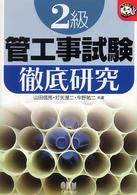- ホーム
- > 洋書
- > 英文書
- > Science / Mathematics
Full Description
A multi-disciplinary, multi-industry overview of microbiologically influenced corrosion, with strategies for diagnosis and control or prevention Microbiologically Influenced Corrosion helps engineers and scientists understand and combat the costly failures that occur due to microbiologically influenced corrosion (MIC). This book combines recent findings from diverse disciplines into one comprehensive reference. Complete with case histories from a variety of environments, it covers:
Biofilm formation
Causative organisms, relating bacteria and fungi to corrosion mechanisms for groups of metals
Diagnosing and monitoring MIC
Electrochemical techniques, with an overview of methods for detection of MIC
The impact of alloying elements, including antimicrobial metals, and design features on MIC
MIC of non-metallics
Strategies for control or prevention of MIC, including engineering, chemical, and biological approaches
This is a valuable, all-inclusive reference for corrosion scientists, engineers, and researchers, as well as designers, managers, and operators.
Contents
Preface xi
1. Biofilm Formation 1
Introduction 1
Biologically Active Environments 1
Biofilm Formation 7
Influence of Conditioning Films 9
Influence of the Substratum 10
Influence of the Electrolyte 14
Summary 16
References 19
2. Causative Organisms and Possible Mechanisms 22
Introduction 22
Ennoblement 22
Concentration Cells 25
Oxygen Concentration Cells 25
Metal Concentration Cells 26
Reactions within Biofilms 26
Respiration/Photosynthesis 28
Sulfide Production 28
Iron 32
Copper 34
Silver 38
Other Metals 41
Acid Production 41
Ammonia Production 41
Metal Deposition 42
Manganese 42
Iron 45
Metal Reduction 47
Methane Production 48
Hydrogen Production 48
Dealloying 49
Inactivation of Corrosion Inhibitor 49
Alteration of Anion Ratios 49
Summary 50
References 50
3. Diagnosing Microbiologically Influenced Corrosion 56
Introduction 56
Identification of Causative Organisms 56
Culture Techniques 56
Biochemical Assays 58
Cell Activity 59
Genetic Techniques 60
Microscopy 61
Light Microscopy 61
Epifluorescence Microscopy 61
Confocal Laser Scanning Microscopy 63
Atomic Force Microscopy 63
Electron Microscopy 63
Pit Morphology 66
Chemical Testing 70
Elemental Composition 71
Mineralogical Fingerprints 72
Isotope Fractionation 73
Summary 73
References 74
4. Electrochemical Techniques Applied to Microbiologically Influenced Corrosion 78
Introduction 78
Techniques Requiring no External Signal 78
Redox Potential 78
Open Circuit or Corrosion Potential, Ecorr 80
Electrochemical Noise Analysis (ENA) 81
Microsensors 81
Scanning Vibrating Electrode Techniques 82
Capacitance 83
Dual-Cell Technique 86
Techniques Requiring a Small External Signal 89
Polarization Resistance Technique 89
Electrochemical Impedance Spectroscopy 92
Large Signal Polarization 94
Concentric Ring Electrodes 96
Summary 97
References 98
5. Approaches for Monitoring Microbiologically Influenced Corrosion 102
Introduction 102
Coupon Holders 103
Zero Resistance Ammeter 104
Multitechnique Approaches 107
Electrochemical Noise Analysis 116
Electrochemical Impedance Spectroscopy 120
Summary 124
References 125
6. Impact of Alloying Elements to Susceptibility of Microbiologically Influenced Corrosion 127
Introduction 127
Low Alloy Steel 138
Copper and Nickel Alloys 129
Stainless Steels 133
Aluminum and Aluminum Alloys 139
Titanium and Titanium Alloys 140
Antimicrobial Metals 141
Summary 143
References 144
7. Design Features that Determine Microbiologically Influenced Corrosion 147
Introduction 147
Hydrotest Procedures 147
Flow 148
Summary 149
References 149
8. Case Histories 150
Introduction 150
Generic Environments 150
Subterranean 150
External Pipeline Surfaces 150
Electric Cables 151
Atmospheric 154
Ship Holds 155
Aircraft 155
Wire Rope 159
Building Materials 159
Glass 162
Marine 162
Iron and Steel 162
Corrosion-resistant and Passive Alloys 173
Copper and Copper-Nickel Alloys 174
Titanium 177
Specific Environments 177
Water-Distribution and Storage Systems 177
Nuclear Waste Storage 186
Interim Wet Storage 186
Long-term Dry Storage 189
Environments with Hydrocarbons 192
Production 193
Transmission, Distribution, and Storage 194
Use 195
Ships 201
Power Generation 203
Paper Mill Industry 206
References 207
9. Microbiologically Influenced Corrosion of Nonmetallics 217
Introduction 217
Polymeric Materials 217
Biomedical Applications 218
Polymeric Coatings 219
Fiber-Reinforced Polymeric Composites 222
Concrete 227
Other Engineering Materials 232
Asphalt 232
Wood 232
Summary 233
References 233
10 Strategies to Prevent or Mitigate Microbiologically Influenced Corrosion 237
Introduction 237
Reduce Numbers and Types of Organisms 237
Biocides 237
Corrosion Inhibition by Biofilms 242
Apparent Contradictions among Researchers 251
The Stochastic Nature of Biofilms 251
Contamination and Natural Competition 251
The Influence of Nutrients on Electrochemical Measurements 252
The Influence of Nutrients on the Corrosion Mechanism 252
Alter Potential Electron Acceptors to Inhibit Specific Groups of Bacteria 253
Summary 257
References 257
Index 261








